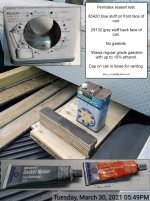What is the best way to seal the fuel tank access plate for no leaks. I have used Vans cork gasket with constant leaks, homemade paper gasket which was better but stilled leaked, and no gasket and proseal with no leaks at all. But, using proseal made it real tough to get off later. Which is the freferred method? I am tired of the seeps of fuel.
49clipper
N189lEM
RV-6
49clipper
N189lEM
RV-6





